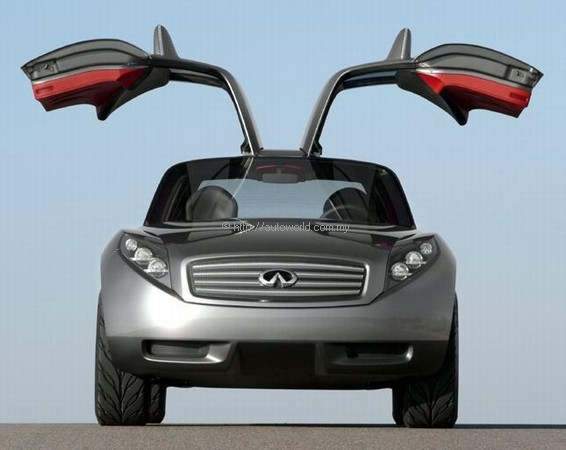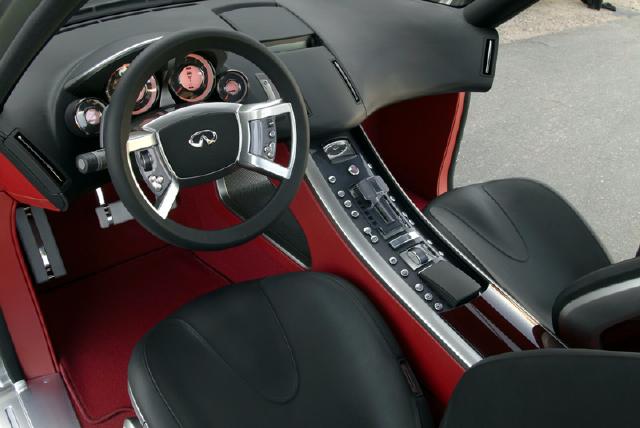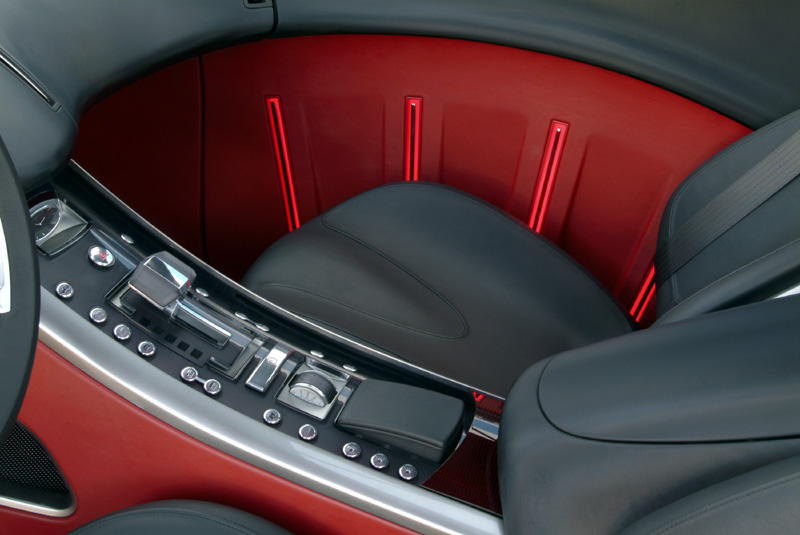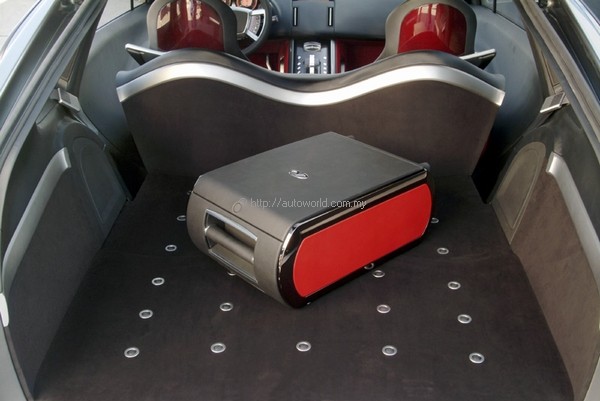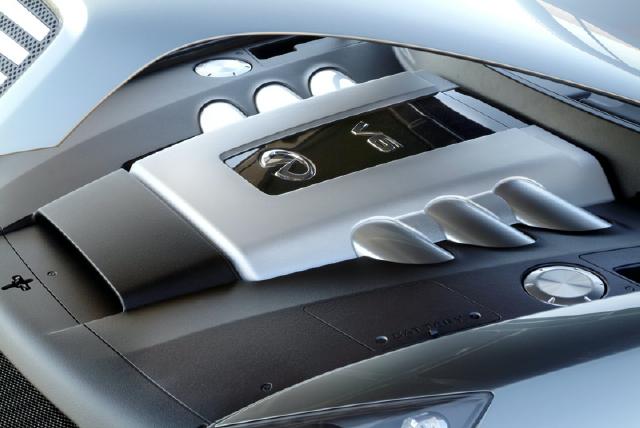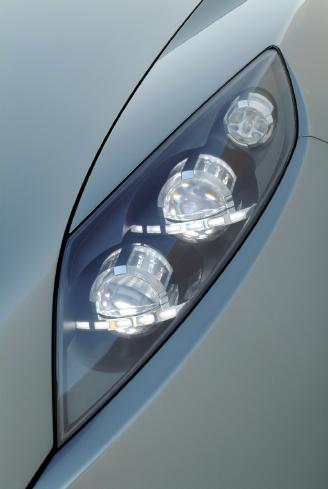Triant – Modern Interpretation of Classic Design
The Infiniti division of Nissan USA is the equivalent of Toyota’s Lexus division; it offers premium luxury products, some of which may share the mechanicals of Nissan models, coupled with extra-special after-sales services.
Functioning as a separate brand, Infiniti also does its own product planning and once in a while, shows off a concept car. The latest is the Triant, described as ‘a modern interpretation of classic sporting vehicles… with a Japanese flavour’.
The theme of Triant’s bodywork is “muscular proportion,” with its set-back 2+2 cabin combined with a long, elegant bonnet, large “double arches” signature Infiniti grille, broad shoulders, steeply raked roofline and oversize wheelwells stuffed with large wheels and tyres.
 |
The muscular “coke bottle” front fender treatment and sophisticated surface transition from the unique headlights, flowing down the inverse curve of the bodysides to the stretched rear fenders, creating an emotional sense of rhythm and power.
The aggressive character of the front is picked up in the rear, with its wide shoulder surface and short overhangs projecting a look of spaciousness and SUV ability.
There are some decidedly contemporary elements like contoured three-lens headlights, clear lens taillights, sculpted side mirrors, integrated bumpers and recessed door opening switches.
The unique feature of the Triant’s body would be its gullwing doors which each stretch over 1.7 metres in length and opening to nearly 2.13 metres in height. The doors, which are electrically-operated and assisted by six gas cylinders each, feature lightweight aluminium construction and a special door opening sensing system which helps avoid hitting people or objects when the doors open or close. Like the gullwing side doors, the large rear hatch swings widely open, offering exceptional access to the flexible cargo area.
The designers’ intent was to remind people of sportscars they used to own or aspire to own, yet at the same time bring to the Triant all the positive features of today’s best designs – like a high eye position for the driver, good ground clearance and ease of entry and exit.
Other major exterior features include an advanced headlight system that “guides” the headlight beams around turns with the aid of digital mapping data and GPS technology. The high beams swing up to 15 degrees, while the low beams swing up to 30 degrees in corners – providing greatly enhanced night visibility, especially on twisty mountain roads.
The Triant’s sporty appearance is also marked by its 8.5×19-inch chromed aluminium wheels and aggressive 255/55R19 low-profile tyres. The exterior paint treatment is a special Liquid Mercury colour with exceptionally deep liquidity.
The inner reaches of the Triant concept’s 2+2 cabin are equally intriguing, combining flexibility for active lifestyles with an Infiniti attention to enhancing the driving experience. It was designed with the understanding that all the unspoken “elements” that combine to make an interior – such as the form, details, materials, textures, lights and atmosphere – should reflect the personality of both the vehicle and the brand.
For the Triant, the interpretation of the “Infiniti feeling” is expressed in its comfort, quality, modernity and authentic Japanese undertones.
The organic and emotional surfaces and lines of the Triant’s interior visually illustrate the designers’ intent of creating an environment that is comfortable to both the touch and to the eye. A careful blending of natural and high-tech materials is utilized to create harmony by “fusing contrast.”
The interior’s natural free-flowing form seems to drape over the instrument panel, door panels and rear seat, merging all three independent elements into one environment. At the same time, the driver-focused elements, such as the front seats, steering wheel and instruments have been designed with a sense of precision and geometric direction.
A central backbone, in the form of the sweeping centre console, visually creates a draping wave that connects the front and rear areas. The result is a natural, organic luxury reinforced by advanced technology features – creating a surprising, intriguing and inviting interior.
Beyond the various design elements, the Triant also features a number of advanced features and equipment. The sportscar-like driving position is complemented by a floating, column-mounted instrument cluster, steering wheel-mounted shift paddles with centre console shift-by-wire automatic transmission shift lever and body-contoured front seats with carbonfibre shell and metal finish frame.
The driver and passenger seats are mounted on active shock absorbers (similar to the design of active engine mounts), each having three preset driving positions – sports, cruising and off-road – with each setting utilizing the shock absorber mounts to give a different driving height and different damping levels to best suit the particular driving style and terrain.
A carbonfibre electrically-sliding centre console cover hides the main control switches when not in use, while the retractable 7.0-inch LCD information centre display with integrated navigation system also tucks neatly out of the way, providing a polished, highly finished look when the Triant is at rest. There is also a large overhead centre console, a pass-through in the centre tunnel and a signature Infiniti analog clock.
The interior also features a surround-sound speaker system with central subwoofer and headliner-mounted tweeters, concealed seat slide-rail system (motorized forward/rear and reclining movements), door-mounted atmospheric lighting panels and welcome lighting mounted in the aluminium kickplates.
The rear seat/rear cargo area is designed for total, spontaneous flexibility, with the deeply contoured rear seat designed to slide forward electrically nearly 500 mm when not in passenger use, essentially doubling the available cargo area. The rear seat structure also includes three secure storage compartments.
Rear deck-mounted lockable “track balls” are included for easy luggage positioning and to help prevent luggage from moving without the use of tie-downs or netting.
While it has a coupe-like appearance, the Triant is a fully capable SUV. With its height-adjustable suspension and SUV-like approach and departure angles – the Triant concept delivers on-road performance to match its sport coupe looks.
At the heart of the Triant is a compact yet powerful 3.5-litre DOHC 24-valve V6 engine, mated to a 5-speed automatic transmission. An advanced Nissan ATTESA ET-S all-wheel drive system provides all-climate driving ability, while the 4-wheel independent suspension combines a comfortable ride with secure road holding. The suspension also can be raised for off-pavement use and lowered for highway driving.
The Triant looks pretty ready for the showroom and who knows, Mr Ghosn may just decide to put it in production if enough people say they want it.



